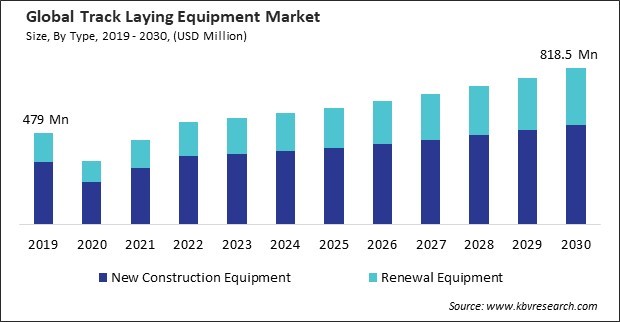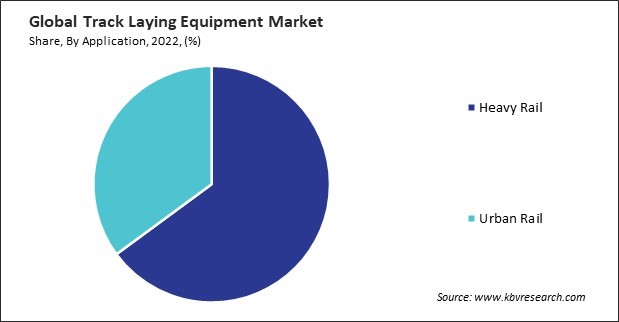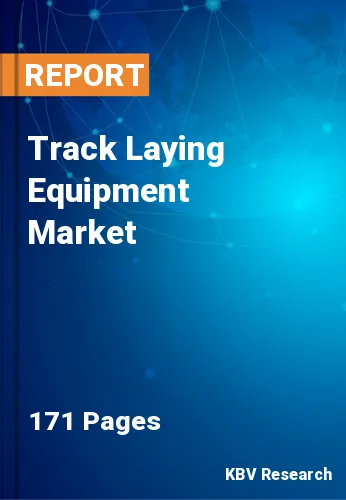“Global Track Laying Equipment Market to reach a market value of USD 818.5 Million by 2030 growing at a CAGR of 5.6%”
The Global Track Laying Equipment Market size is expected to reach $818.5 million by 2030, rising at a market growth of 5.6% CAGR during the forecast period.
Track maintenance involves optimizing track geometry to ensure smooth and safe operations. Thus, the Renewal Equipment segment acquired $1,76,058.7 thousand revenue in 2022. Track laying equipment is designed to align and adjust tracks accurately, addressing issues such as track misalignment and uneven surfaces and ensuring the proper curvature for safe train travel. Advancements in technology and safety standards often necessitate the upgrading of existing tracks. It replaces outdated components, improves signaling systems, and upgrades tracks to meet modern load-bearing capacity, speed, and safety standards.

Urbanization leads to more people in cities, increasing traffic congestion and the need for efficient public transportation. The expansion of urban transit systems, such as metro, light rail transit (LRT), and tram networks, drives the demand for track laying equipment to construct and extend railway lines. Urbanization often leads to the development of multimodal transportation hubs where different modes of transportation converge. It plays a crucial role in creating integrated rail networks that connect seamlessly with other modes of transportation, providing commuters with convenient transit options. Additionally, Electrified rail systems contribute to reducing the carbon footprint of transportation. Electric trains are generally more energy-efficient and produce fewer greenhouse gas emissions than diesel ones. The adoption of electrification trends aligns with sustainability goals and environmental regulations. The electrification trend aligns with integrating renewable energy sources into rail networks. Electrified tracks offer a platform for generating electricity from renewable sources such as solar, wind, and hydroelectric power. It facilitates the creation of sustainable and renewable energy-powered rail infrastructure. Hence, sustainability and electrification trends has been a pivotal factor in driving the growth of the market.
However, high upfront costs can render rail projects financially less viable, especially when the return on investment is uncertain or where funding sources are limited. This can reduce the number of planned projects, negatively impacting the demand for track laying equipment. The financial challenges associated with acquiring track laying equipment can contribute to delays in project kickoffs. Rail operators may face difficulties securing the necessary funding, causing postponements in procuring equipment and initiating construction projects. The high initial costs associated with manufacturing track laying equipment can limit the number of companies entering the market. This can result in a more concentrated market with limited competition, potentially impacting pricing dynamics and innovation within the sector.
Based on application, the market is classified into heavy rail and urban rail. The urban rail segment acquired a substantial revenue share in the market in 2022. Urban rail projects often involve tight spaces and complex urban landscapes. The expansion of urban rail networks drives the demand for compact and versatile track laying equipment to navigate urban environments, including tunnels, elevated structures, and densely populated areas. Minimizing noise and vibrations associated with rail operations is crucial in urban environments. Track laying equipment for urban rail projects integrates features to control noise and vibrations, contributing to a more comfortable and environmentally friendly transit experience for urban residents.

By type, the market is categorized into new construction equipment and renewal equipment. In 2022, the new construction equipment segment held the highest revenue share in the market. New construction equipment often incorporates advanced technologies such as automation, GPS guidance, telematics, and real-time monitoring systems. This integration enhances the precision and efficiency of track laying processes. Automated features contribute to accurate track alignment, reducing the margin for error and minimizing the need for manual adjustments. Incorporating new construction equipment into the track laying process optimizes resource utilization. These machines are designed to operate efficiently, minimizing fuel consumption, and reducing the environmental impact. Smart technologies help monitor equipment usage patterns, allowing for proactive maintenance and extending the lifespan of the machinery.
Free Valuable Insights: Global Track Laying Equipment Market size to reach USD 818.5 Million by 2030
Region-wise, the market is analysed across North America, Europe, Asia Pacific, and LAMEA. In 2022, the Asia Pacific region led the market by generating the highest revenue share. Rapid urbanization and population growth characterize the Asia-Pacific region, which has increased the demand for efficient transportation systems. The Asia Pacific region has been at the forefront of implementing technological advances in railway construction. Urban transit expansion, including the development of metro systems and tram networks, is a key driver of the track laying equipment in the Asia Pacific region.
| Report Attribute | Details |
|---|---|
| Market size value in 2022 | USD 535.3 Million |
| Market size forecast in 2030 | USD 818.5 Million |
| Base Year | 2022 |
| Historical Period | 2019 to 2021 |
| Forecast Period | 2023 to 2030 |
| Revenue Growth Rate | CAGR of 5.6% from 2023 to 2030 |
| Number of Pages | 171 |
| Number of Tables | 240 |
| Report coverage | Market Trends, Revenue Estimation and Forecast, Segmentation Analysis, Regional and Country Breakdown, Porter’s 5 Forces Analysis, Company Profiling, Companies Strategic Developments, SWOT Analysis, Winning Imperatives |
| Segments covered | Type, Application, Region |
| Country scope |
|
| Companies Included | Plasser & Theurer, Larsen & Toubro Limited, Techne Kirow GmbH, Weihua Group Co., Ltd. (Henan Weihua Heavy Machinery Co., LTD.), Matisa Matériel Industriel S.A., CRRC Corporation Limited, Salcef Group S.p.A., Enviri Corporation, BEML Limited, Vossloh AG |
By Application
By Type
By Geography
This Market size is expected to reach $818.5 million by 2030.
Increasing urbanization and population growth are driving the Market in coming years, however, High initial costs of track laying equipment restraints the growth of the Market.
Plasser & Theurer, Larsen & Toubro Limited, Techne Kirow GmbH, Weihua Group Co., Ltd. (Henan Weihua Heavy Machinery Co., LTD.), Matisa Matériel Industriel S.A., CRRC Corporation Limited, Salcef Group S.p.A., Enviri Corporation, BEML Limited, Vossloh AG
The expected CAGR of this Market is 5.6% from 2023 to 2030.
The Heavy Rail segment is leading the Market, By Application in 2022; thereby, achieving a market value of $519.5 million by 2030.
The Asia Pacific region dominated the Market, By Region in 2022, and would continue to be a dominant market till 2030; thereby, achieving a market value of $299.1 million by 2030.
Our team of dedicated experts can provide you with attractive expansion opportunities for your business.

 Drivers
Drivers
 Restraints
Restraints
 Opportunities
Opportunities
 Challenges
Challenges
